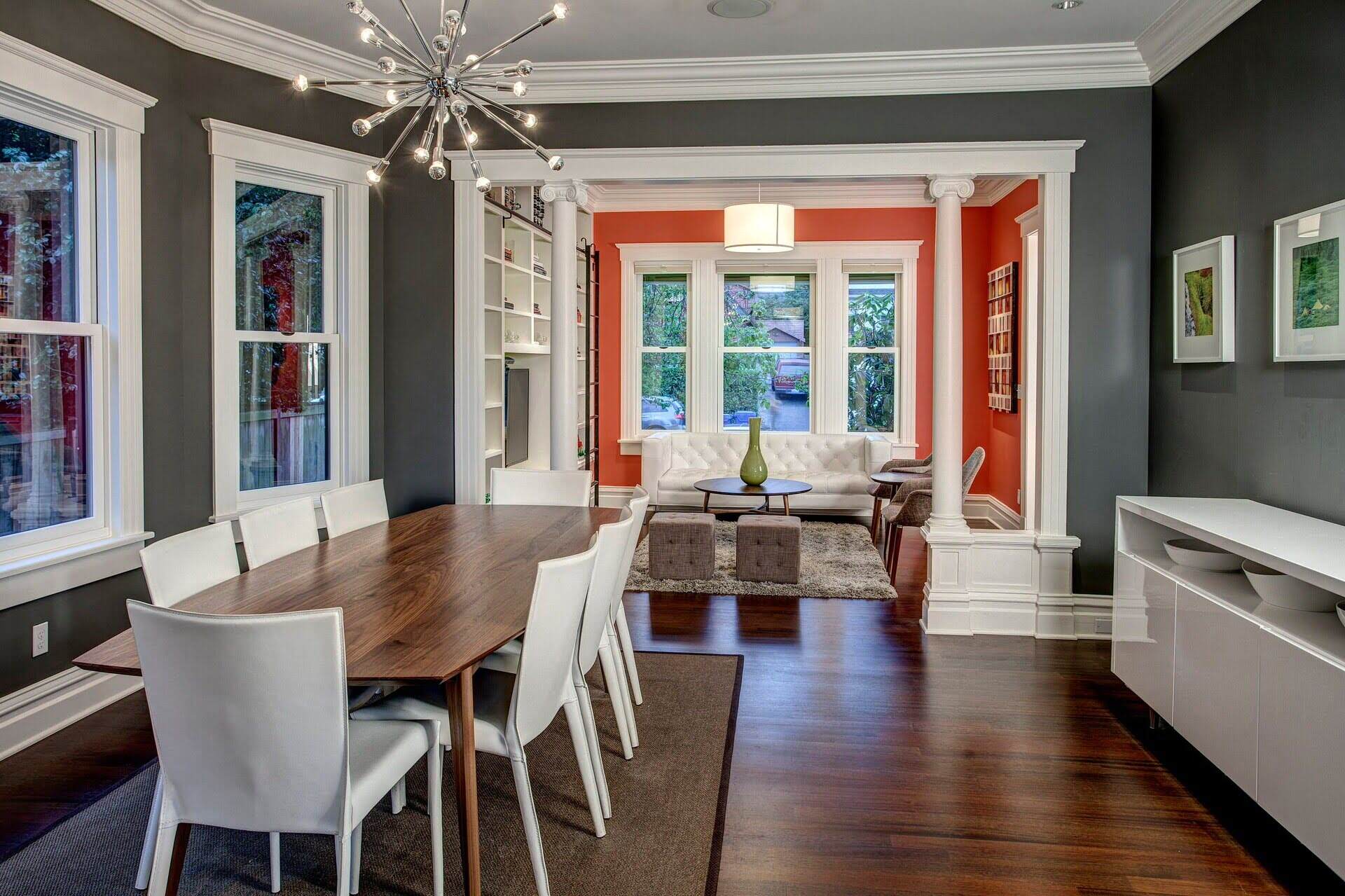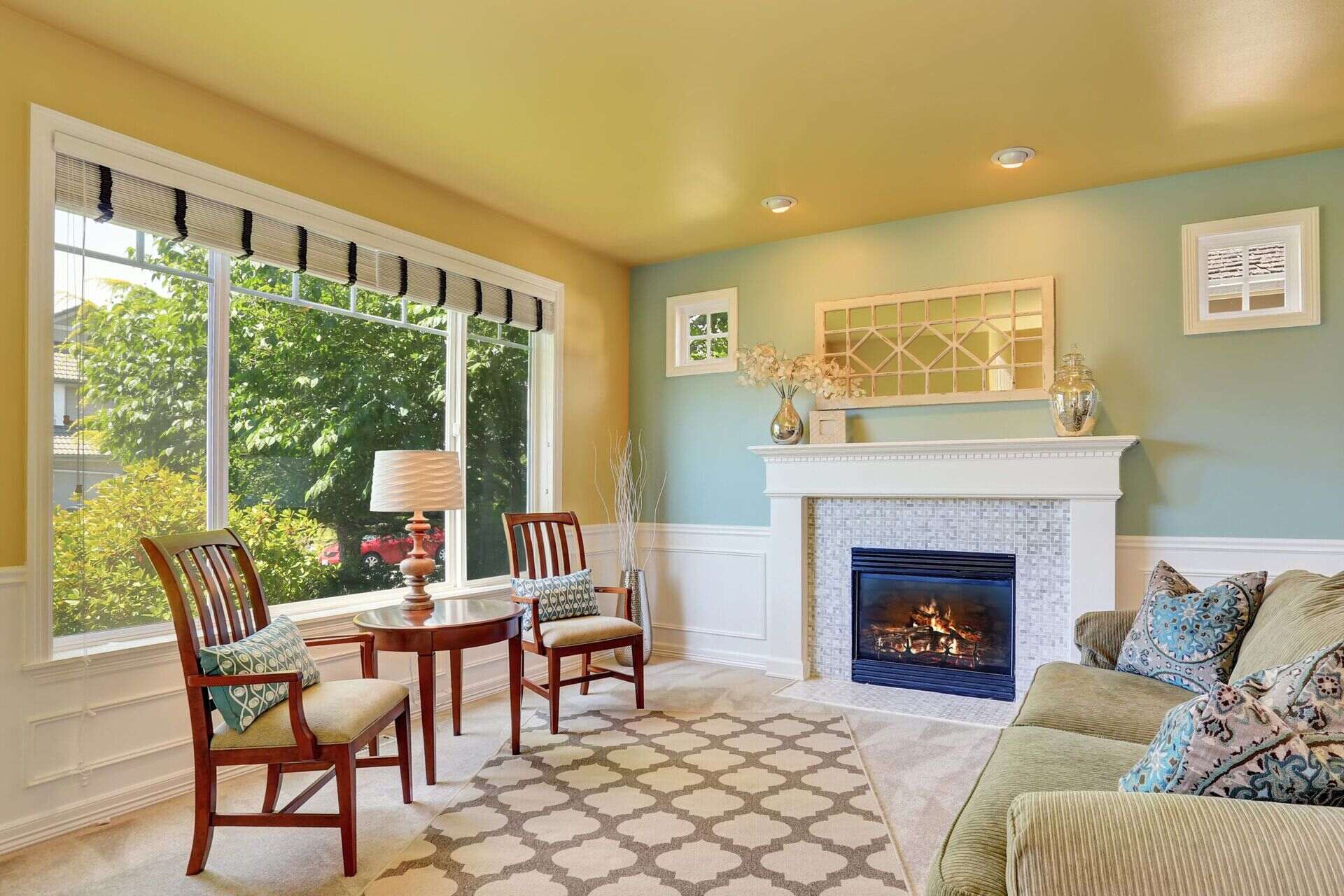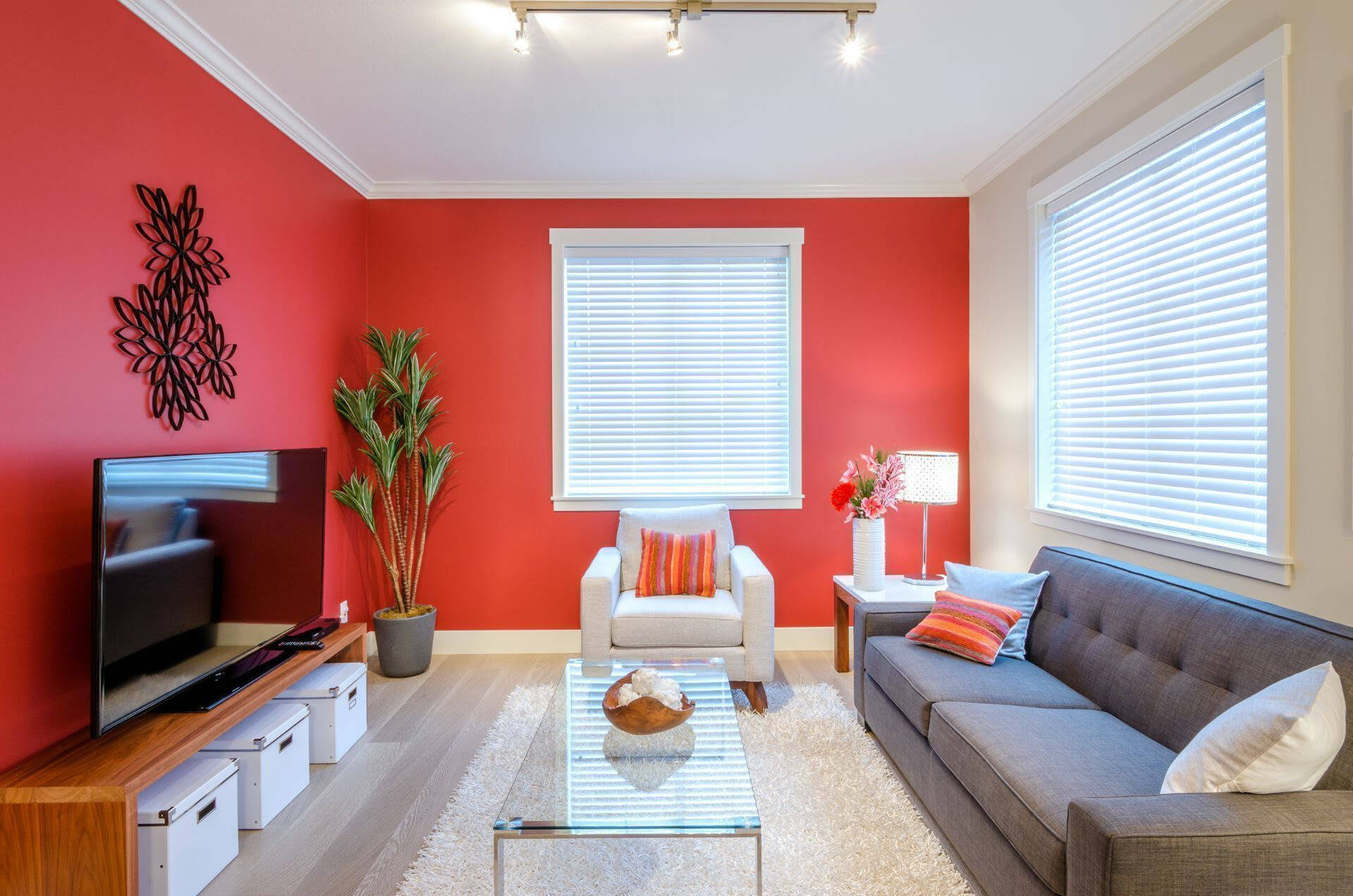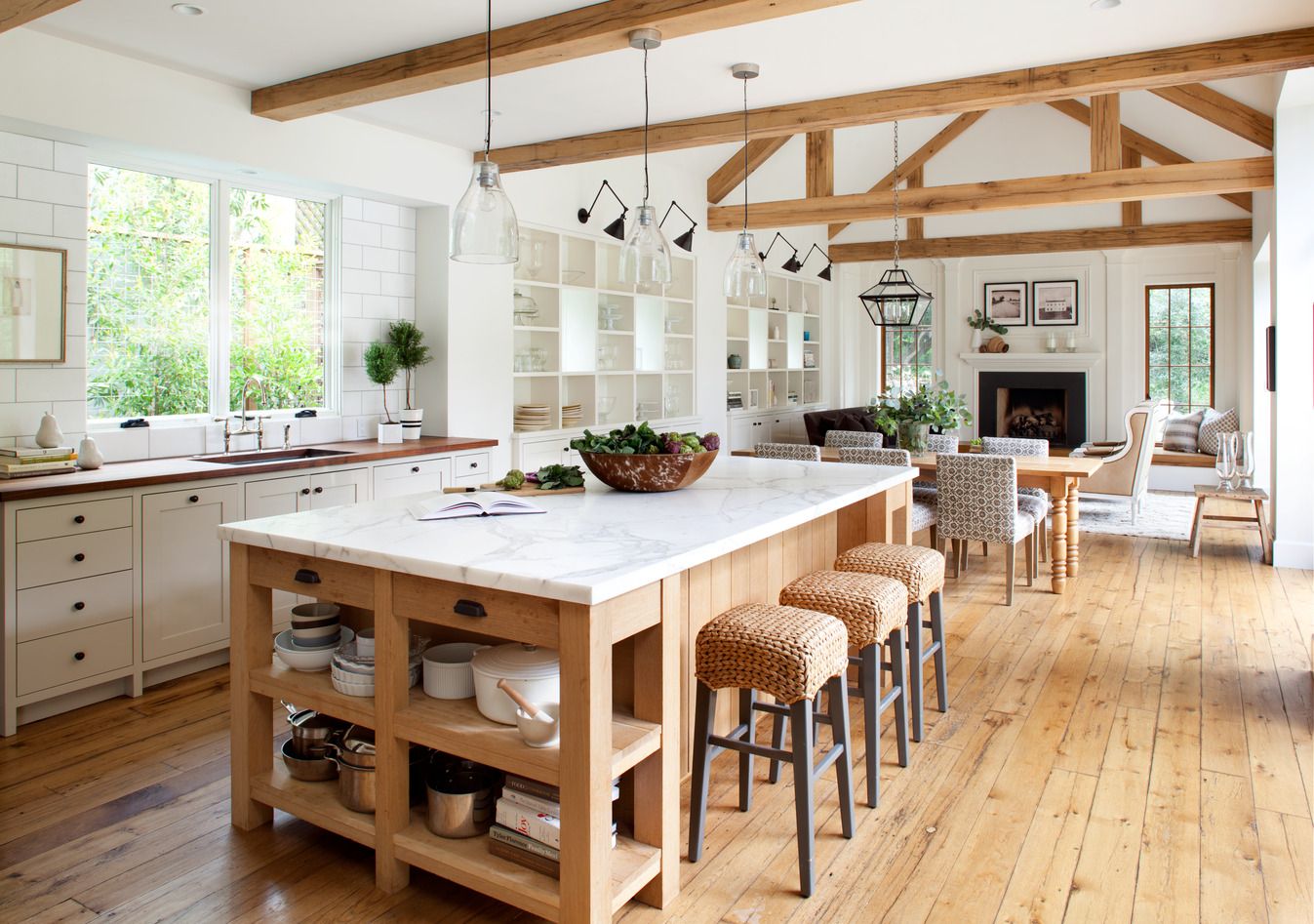

Articles
How To Paint Living Room
Modified: April 23, 2024
Learn the best techniques for painting your living room with our informative articles. Transform your space with ease and achieve professional-looking results.
(Many of the links in this article redirect to a specific reviewed product. Your purchase of these products through affiliate links helps to generate commission for Storables.com, at no extra cost. Learn more)
Introduction
Welcome to our guide on how to paint your living room! Painting is a great way to freshen up your space and give it a new look. Whether you’re looking to update the color scheme, hide imperfections, or simply add a personal touch, painting your living room can make a significant difference.
While it may seem like a daunting task, with the right preparation and technique, anyone can successfully paint their living room. In this article, we will walk you through the step-by-step process of painting your living room, from choosing the right paint colors to adding the finishing touches.
Before we dive into the details, it’s important to note that the success of your painting project greatly depends on the preparation you put into it. Taking the time to properly prepare your living room and gather the necessary supplies will ensure a smoother and more enjoyable painting experience.
So, without further ado, let’s get started on transforming your living space and creating a fresh and inviting atmosphere through the power of paint!
Key Takeaways:
- Transform your living room with the power of paint! From choosing the right colors to adding the finishing touches, this guide will help you achieve a professional and personalized look for your space.
- Don’t underestimate the impact of proper preparation and technique when painting your living room. Take the time to select the right colors, gather quality supplies, and apply paint with care to achieve stunning, long-lasting results.
Choosing the Right Paint Colors
When it comes to painting your living room, choosing the right colors is crucial. The color you choose will set the tone for the entire space and greatly impact the overall atmosphere of the room. Here are a few tips to help you select the perfect paint colors for your living room:
- Consider the existing elements: Take into account the color of your furniture, flooring, and other fixed features in the room. You want to choose colors that complement and enhance these elements rather than clash with them.
- Think about the mood: Decide on the mood you want to create in your living room. Do you want it to be cozy and intimate, or bright and energetic? Cool colors like blues and greens can create a calming atmosphere, while warm colors like reds and yellows can add a vibrant touch.
- Test different shades: Don’t be afraid to experiment with different shades and tones. Paint swatches on the wall or use online tools to get a better idea of how different colors will look in your living room. Remember, lighting can significantly affect the appearance of paint colors, so assess them in both natural and artificial light.
- Consider the size of the room: Lighter colors can make a small living room feel more spacious and airy, while darker colors can create a cozy and intimate ambiance in larger rooms.
- Stay true to your style: Think about your personal style and the overall theme of your living room. Whether you prefer a modern, traditional, or eclectic look, choose paint colors that align with your aesthetic.
Once you have narrowed down your options, it’s always a good idea to purchase small sample cans of paint and test them on the wall. This will give you a better sense of how the colors will look in your specific space. Don’t rush this process, as finding the perfect paint colors can truly transform your living room.
Remember, if you’re unsure about which colors to choose, you can always consult with a professional interior designer or utilize online resources for inspiration. Trust your instincts and go with colors that make you feel happy and comfortable in your living room.
Selecting the Paint Finish
Once you have chosen the perfect paint colors for your living room, it’s time to consider the paint finish. The finish you choose will not only affect the appearance of the paint, but also its durability and ease of cleaning. Here are some popular paint finishes and their characteristics:
- Flat Finish: This finish has a smooth and non-reflective appearance. It is great for hiding imperfections on the walls and providing a matte finish. However, it is not very durable and can be difficult to clean, so it’s not recommended for high-traffic areas.
- Eggshell Finish: This finish has a subtle sheen and offers a more durable and washable surface compared to flat finish. It is a popular choice for living rooms as it provides a soft, velvety appearance.
- Satin Finish: This finish has a slightly higher sheen than eggshell and offers better durability and washability. It is a good choice for high-traffic areas as it can resist stains and can be easily wiped clean.
- Semi-gloss Finish: This finish has a noticeable sheen and is highly durable and washable. It is commonly used on trim, doors, and cabinets. It reflects more light and gives a polished and elegant look to the living room.
- Gloss Finish: This finish has the highest sheen and provides a glossy and reflective appearance. It is extremely durable and easy to clean, but it can show imperfections on the walls. Gloss finish is typically used on specialty areas like accent walls or furniture.
When selecting the paint finish for your living room, consider the level of activity and traffic in the space. If you have young children or pets, it may be wise to choose a more durable finish that can withstand frequent cleaning.
Additionally, keep in mind the aesthetics you want to achieve. A flat or eggshell finish can create a more relaxed and cozy atmosphere, while a semi-gloss or gloss finish can make your living room look more polished and sophisticated.
Ultimately, the choice of paint finish is a matter of personal preference and the specific needs of your living room. Take the time to consider the pros and cons of each finish and select the one that best suits your style and lifestyle.
Preparing the Living Room Walls
Before you start painting your living room walls, it’s important to properly prepare the surface. This step is crucial for ensuring a smooth and long-lasting paint finish. Here’s a step-by-step guide on how to prepare your living room walls:
- Clear the room: Remove all furniture, decorations, curtains, and fixtures from the walls and cover the floor with drop cloths or plastic sheets to protect it from paint splatters.
- Repair any damages: Inspect the walls for any holes, cracks, or dents. Use a putty knife and spackle or joint compound to fill in these imperfections. Allow the compound to dry completely and then sand it down to create a smooth surface.
- Clean the walls: Remove any dust, dirt, or grease from the walls using a mild detergent and water mixture. Scrub gently with a sponge or soft cloth to ensure a clean surface for the paint to adhere to. Rinse the walls with clean water and allow them to dry fully before proceeding.
- Protect the trim and baseboards: Use painter’s tape to cover the edges of the trim, baseboards, and any other areas you want to protect from paint. This will ensure clean lines and prevent any accidental paint drips.
- Prime the walls (if needed): If you are painting over a dark or patchy color, or if your walls are porous, it is recommended to apply a coat of primer. Primer helps to create an even surface and improves the adhesion of the paint. Apply the primer following the manufacturer’s instructions and allow it to dry before proceeding.
By taking the time to properly prepare your living room walls, you are laying the foundation for a professional-looking paint job. This step ensures that the paint adheres well and provides a smooth and flawless finish.
Remember to always read and follow the instructions provided by the paint and primer manufacturers for the best results. Once your walls are properly prepped, you are ready to move on to the next steps of the painting process.
Gathering the Necessary Painting Supplies
Before you begin painting your living room, it’s essential to gather all the necessary supplies. Having the right tools and materials will make the process easier and more efficient. Here’s a list of the key painting supplies you’ll need:
- Paint rollers and brushes: Choose high-quality paint rollers and brushes that are suitable for the type of paint and finish you’ll be using. Synthetic brushes are typically used for water-based paints, while natural bristle brushes are better suited for oil-based paints.
- Paint trays: Get a paint tray or roller tray to pour the paint into for easy accessibility while you’re painting.
- Drop cloths or plastic sheets: Cover your furniture and floors with drop cloths or plastic sheets to protect them from paint splatters. This will make the cleanup process much easier.
- Painter’s tape: Use painter’s tape to create clean edges and protect areas that you don’t want to be painted, such as trim, baseboards, and windows.
- Spackle or joint compound: Fill in any holes or cracks in the walls using spackle or joint compound. A putty knife will be needed for this task.
- Sandpaper or sanding block: Use sandpaper or a sanding block to smooth out any rough patches and ensure a smooth surface for painting.
- Primer: If you need to prime your walls before painting, make sure to have the appropriate primer based on the type of paint you’ll be using.
- Paint: Purchase the desired paint color and finish for your living room. Make sure to choose paint that is suitable for the type of walls you have (e.g., water-based paint for drywall).
- Paint stirrer: Use a paint stirrer to thoroughly mix the paint before starting the project. This ensures a consistent color and texture.
- Painting clothes and protective gear: Wear old clothes that you don’t mind getting paint on and consider wearing gloves, goggles, and a face mask to protect yourself from paint splatters and fumes.
- Ladder or step stool: Depending on the height of your walls, you may need a ladder or step stool to reach higher areas.
- Clean-up supplies: Keep a bucket filled with water for cleaning your brushes and rollers. Have rags or paper towels on hand for wiping up any spills or drips.
Make sure to check your supplies before starting the project to ensure you have everything you need. This will save you time and prevent disruptions during the painting process.
Remember, investing in high-quality tools and materials will not only provide better results but also make the painting process more enjoyable. So, gather your supplies and get ready to transform your living room with a fresh coat of paint!
Read more: How To Choose A Painting For Living Room
Applying Primer to the Walls
Applying primer to your living room walls is an important step before painting, especially if you’re dealing with stains, dark colors, or porous surfaces. Primer helps to create a smooth and even surface, improves paint adhesion, and enhances the overall longevity of the paint job. Follow these steps to apply primer to your walls:
- Prepare the area: Clear the room of furniture and cover the floor with drop cloths or plastic sheets to protect it from primer splatters.
- Prepare the walls: Ensure that the walls are clean, dry, and free from any dust or debris. Use a mild detergent and water solution to wipe down the walls and remove any dirt or grease. Allow the walls to dry completely.
- Stir the primer: Open the can of primer and use a paint stirrer to thoroughly mix the primer. This will ensure an even consistency and color throughout.
- Apply the primer: Pour some primer into a paint tray and load your roller. Start at a corner of the room and work your way across the wall in small sections. Use a roller to apply an even coat of primer to the wall, using long, vertical strokes. Be sure to cover the entire surface, including corners and edges.
- Cut in with a brush: Use a paintbrush to cut in around trim, corners, and edges that the roller may not reach. This will ensure a clean and precise application.
- Allow the primer to dry: Check the drying time specified by the manufacturer. Typically, primer takes around 2-4 hours to dry, but this may vary depending on room temperature and humidity. Ensure that the primer is completely dry before proceeding to the next steps.
- Sand the walls (optional): If you notice any rough areas or imperfections after the primer has dried, lightly sand the walls with sandpaper or a sanding block to create a smooth surface for the paint.
- Inspect and touch-up if necessary: Once the primer is dry, assess the walls for any missed spots or areas that require touch-up. Apply primer to these areas and allow them to dry before continuing with the painting process.
Priming your walls provides a solid foundation for the paint and ensures a uniform and professional finish. It is an essential step for achieving long-lasting and flawless results. Don’t skip this step, especially if you’re painting over a darker color or dealing with stains or imperfections on the walls. It will make a significant difference in the overall outcome of your painting project.
After applying the primer and ensuring it has dried completely, you’re ready to start painting your living room walls with your chosen color. The primer sets the stage for your paint to shine, so take the time to do it right and enjoy the benefits of a beautifully painted living room.
When painting a living room, start by preparing the walls by cleaning and sanding them. Use painter’s tape to protect trim and edges, and consider using a primer before applying the paint for better coverage and durability.
Painting the Living Room Ceiling
Painting the ceiling is an important step in refreshing the look of your living room. While it may seem like a challenging task, with the right approach and tools, you can achieve a smooth and flawless finish. Here’s a step-by-step guide on how to paint your living room ceiling:
- Prepare the area: Clear the room of any furniture and cover the floor with drop cloths or plastic sheets to protect it from paint splatters.
- Protect walls and trim: Use painter’s tape to protect the walls and trim from any accidental paint drips or splatters. Apply the tape along the edges of the walls and the trim, ensuring a clean line.
- Clean the ceiling: Remove any dust or cobwebs from the ceiling using a broom or vacuum cleaner with a brush attachment. It’s important to start with a clean surface for better paint adhesion.
- Repair any damages: Inspect the ceiling for any cracks or holes. Use spackle or joint compound to fill in these imperfections. Allow the compound to dry and then sand it down to create a smooth surface.
- Apply a coat of primer (if needed): If your ceiling has stains or a darker color, apply a coat of primer to even out the surface and improve paint coverage. Follow the manufacturer’s instructions and allow the primer to dry completely.
- Choose the right paint and tools: Select a high-quality ceiling paint specifically formulated for ceilings. Use a roller with an extension pole for reaching high areas. A paintbrush may be needed for cutting in around light fixtures or corners.
- Start painting: Begin at one corner of the ceiling and work your way across the room. Use long, overlapping strokes with the roller to ensure an even application. Apply light pressure to avoid drips and work in sections to maintain a wet edge.
- Blend the sections: To achieve a seamless finish, blend the sections together by slightly overlapping the edges while the paint is still wet. This will prevent visible lines or streaks.
- Cut in around edges: Use a paintbrush to cut in along the edges of the ceiling, near walls, and around fixtures. Take your time and be precise to achieve clean lines.
- Allow the paint to dry thoroughly: Check the drying time specified by the paint manufacturer. Typically, ceiling paint takes a few hours to dry, but it’s best to leave it overnight to ensure it’s fully cured before applying a second coat.
- Apply a second coat (if needed): Once the first coat is dry, assess the coverage. If necessary, apply a second coat by repeating the same process to achieve a solid and uniform finish.
- Remove the painter’s tape: Once the paint is completely dry, carefully remove the painter’s tape from the walls and trim at a 45-degree angle. This will help create a clean and sharp edge.
Painting the ceiling can be a time-consuming task, but it greatly contributes to the overall transformation of your living room. A fresh coat of paint on the ceiling can brighten up the space and give it a clean and polished look.
Remember to work in a well-ventilated area and take breaks when necessary. Don’t forget to use appropriate safety equipment, such as goggles and a mask, to protect yourself from paint splatters and fumes.
With a little patience and attention to detail, you can successfully paint your living room ceiling and create a visually appealing and inviting space.
Painting the Living Room Walls
Now that you’ve prepared the surfaces and painted the ceiling, it’s time to move on to painting the walls of your living room. This is where the transformation truly takes shape, and you can customize the space with your chosen paint color. Follow these steps to paint your living room walls:
- Prepare the area: Clear the room of any furniture and cover the floor with drop cloths or plastic sheets to protect it from paint splatters. Remove any outlet covers or light switch plates.
- Stir the paint: Open the can of paint and use a paint stirrer to thoroughly mix the paint. This helps to evenly distribute the pigment and ensures consistent color throughout the project.
- Start with cutting in: Use a paintbrush to cut in along the edges of the walls, near the ceiling, corners, and baseboards. Take your time to achieve clean lines and ensure that the paintbrush bristles are fully coated with paint.
- Load the roller: Pour some paint into a paint tray and evenly distribute the paint on the roller. Roll it back and forth in the tray to ensure the entire roller is coated with paint.
- Begin painting: Start at a corner of the room and work your way across the wall in small sections. Use the roller to apply the paint in an “M” or “W” shape and then fill in the gaps with vertical strokes. This technique helps distribute the paint evenly and prevents streaking.
- Keep a wet edge: Work quickly to maintain a “wet edge” as you move from one section to another. This means that you should overlap each stroke with the previous one while the paint is still wet. This prevents visible lines or unevenness in paint application.
- Apply multiple coats if necessary: Depending on the color and type of paint you’re using, you might need to apply multiple coats for full coverage. Allow each coat to dry completely before applying the next one. Check the paint can for recommended drying times.
- Blend the sections: To ensure a seamless finish, blend each section together by slightly overlapping the edges while the paint is still wet. This helps to create a consistent appearance without visible lines or demarcations.
- Inspect and touch up: Once the paint is dry, inspect the walls for any missed spots or areas that require touch-ups. Use a small brush to carefully fill in these areas, blending them with the rest of the painted surface.
- Reinstall outlet covers and switch plates: Once the paint is completely dry, replace the outlet covers and switch plates that were removed earlier. Be sure to clean off any paint drips or smudges on the covers before reinstalling them.
- Clean up: Properly clean your paintbrushes, roller, and paint tray according to the manufacturer’s instructions. Remove the drop cloths or plastic sheets from the floor and dispose of any paint cans or other materials responsibly.
Painting the walls of your living room gives you the opportunity to express your style and create a personalized space. Take your time during the process and pay attention to detail to achieve a professional and polished look.
Remember to take breaks when necessary, work in a well-ventilated area, and use appropriate safety equipment, such as goggles and a mask, to protect yourself from paint splatters and fumes.
With each stroke of the brush or roll of the roller, you’ll be closer to seeing your living room transform into a fresh and inviting space that reflects your unique taste.
Painting the Trim and Baseboards
As you near the end of your painting project, don’t forget about the trim and baseboards. Painting these areas will provide a polished and cohesive look to your living room. Follow these steps to paint the trim and baseboards:
- Prepare the area: Ensure that the walls are dry and free from any paint splatters. Position drop cloths or plastic sheets to protect the floor from any potential drips.
- Clean the trim and baseboards: Before painting, wipe down the trim and baseboards to remove any dust, dirt, or grime. Use a mild detergent and water solution and a clean cloth or sponge. Allow them to dry completely.
- Protect the walls: Place painter’s tape along the edges of the walls adjacent to the trim and baseboards. This will create a clean line and prevent any accidental paint marks on the walls.
- Prime, if necessary: If the trim or baseboards are bare wood or have dark existing paint, it’s recommended to apply a coat of primer first. Primer helps the paint adhere better and provides a more even finish. Allow the primer to dry fully before proceeding.
- Choose the appropriate paint: Select a high-quality trim paint with a finish that matches or complements the walls. Oil-based paint is commonly used for trim, but water-based options are also available and are more environmentally friendly.
- Prepare the paint and tools: Stir the paint thoroughly to ensure an even consistency. Use a smaller brush for intricate details and a larger angled brush for broader areas like baseboards. Consider using a small foam roller for smooth surfaces.
- Start with the trim: Begin painting the trim, starting from the top and working your way down. Apply the paint with smooth, even strokes, following the natural direction of the wood grain. Take care to avoid drips or excess paint buildup.
- Paint the baseboards: Once the trim is dry, move on to the baseboards. Start at one end and work your way along the length of each baseboard. Use long, even strokes, applying the paint with precision.
- Allow the paint to dry: Check the drying time specified by the paint manufacturer. Typically, trim paint dries faster than wall paint. Ensure each coat is fully dry before applying additional coats, if necessary.
- Inspect and touch up if needed: Once the paint is dry, carefully inspect the trim and baseboards for any missed spots or imperfections. Use a small brush to touch up these areas, ensuring a flawless finish.
- Remove the painter’s tape: After the paint has fully dried, gently remove the painter’s tape at a 45-degree angle to prevent paint from peeling off. Take your time to create clean, crisp lines.
Painting the trim and baseboards can give your living room a finished and refined look. Take your time, pay attention to detail, and ensure even coverage for a professional-looking result.
Remember to work in a well-ventilated area and allow for proper drying time between each coat. Clean your brushes and tools as per the manufacturer’s instructions and dispose of any waste responsibly.
With the completion of the trim and baseboard painting, your living room transformation will be almost complete. Take a step back and admire the hard work you’ve put into creating a fresh and inviting space.
Read more: How Long To Paint A Living Room
Cleaning Up and Finishing Touches
Now that you’ve finished painting your living room, it’s time to clean up and add the final touches to complete the transformation. Follow these steps to ensure a neat and polished finish:
- Clean your painting tools: Start by cleaning your paintbrushes, rollers, and paint trays. Follow the manufacturer’s instructions to properly clean and store your tools for future use. Dispose of any empty paint cans or other painting materials responsibly.
- Remove drop cloths and plastic sheets: Carefully remove the drop cloths or plastic sheets from the floor and furniture, being cautious not to spread any paint residue. Shake them outside to remove any excess paint, and then fold or roll them for future use or disposal.
- Inspect the walls: Take a close look at your newly painted walls to ensure a smooth and even finish. If you notice any drips, smudges, or imperfections, use a small brush to touch them up with a bit of matching paint.
- Replace outlet covers and switch plates: Reinstall the outlet covers and switch plates that were removed before painting. Wipe them clean if they have any paint smudges before attaching them back in place.
- Clean light fixtures and ceiling fans: If your living room has any light fixtures or ceiling fans, take the opportunity to clean them. Remove dust and debris using a soft cloth or a duster. This will help enhance the overall appearance of the room.
- Inspect the trim and baseboards: Examine the freshly painted trim and baseboards to ensure a clean and flawless finish. Use a small brush to touch up any areas that require additional paint or attention.
- Remove painter’s tape: Carefully remove the painter’s tape from the walls and trim at a 45-degree angle. Be gentle to ensure that the paint lines remain crisp and clean. Dispose of the tape properly.
- Clean the living room: Take the time to clean the entire living room once the painting is complete. Dust and wipe down surfaces, vacuum or sweep the floor, and give the room an overall tidy. This will add a final touch of freshness to your newly painted space.
- Admire your work: Step back and admire your newly painted living room. Take pride in the time and effort you’ve put into transforming the space. Enjoy the enhanced atmosphere and the personal touch you’ve added to your home.
Cleaning up after a painting project is just as important as the painting itself. By following these steps, you can ensure a clean and well-finished result, leaving your living room looking fresh and inviting.
Remember to properly store any leftover paint for touch-ups in the future. Label the can with the color, room, and date for easy reference. Dispose of any excess paint responsibly, following the local regulations for hazardous waste disposal.
With the cleaning complete, you can now sit back, relax, and appreciate your newly painted living room. Take the time to enjoy the transformation and the renewed atmosphere of your space.
Conclusion
Congratulations! You have successfully completed the transformation of your living room through the power of paint. By following the step-by-step guide in this article, you have learned how to choose the right paint colors, select the appropriate paint finish, prepare the walls, gather the necessary supplies, apply primer, paint the ceiling, paint the walls, paint the trim and baseboards, clean up, and add the finishing touches.
Painting your living room can truly breathe new life into the space. It allows you to express your personal style, create a fresh atmosphere, and add a personalized touch to your home. The right paint colors and finishes can set the mood, highlight architectural features, and enhance the overall aesthetic appeal of your living room.
Remember, thorough preparation and proper technique are key to achieving a professional and flawless paint job. Take your time, follow the instructions, and be mindful of details. By investing the effort into prepping the walls, choosing quality paint and tools, and applying the paint carefully, you can achieve stunning results that will last for years to come.
Don’t forget to clean up after your painting project and admire the final product. Take pride in your accomplishment and enjoy the newfound beauty and freshness of your living room.
We hope that this guide has been informative and helpful in guiding you through the process of painting your living room. Now, go ahead and enjoy your newly transformed space!
Frequently Asked Questions about How To Paint Living Room
Was this page helpful?
At Storables.com, we guarantee accurate and reliable information. Our content, validated by Expert Board Contributors, is crafted following stringent Editorial Policies. We're committed to providing you with well-researched, expert-backed insights for all your informational needs.














0 thoughts on “How To Paint Living Room”